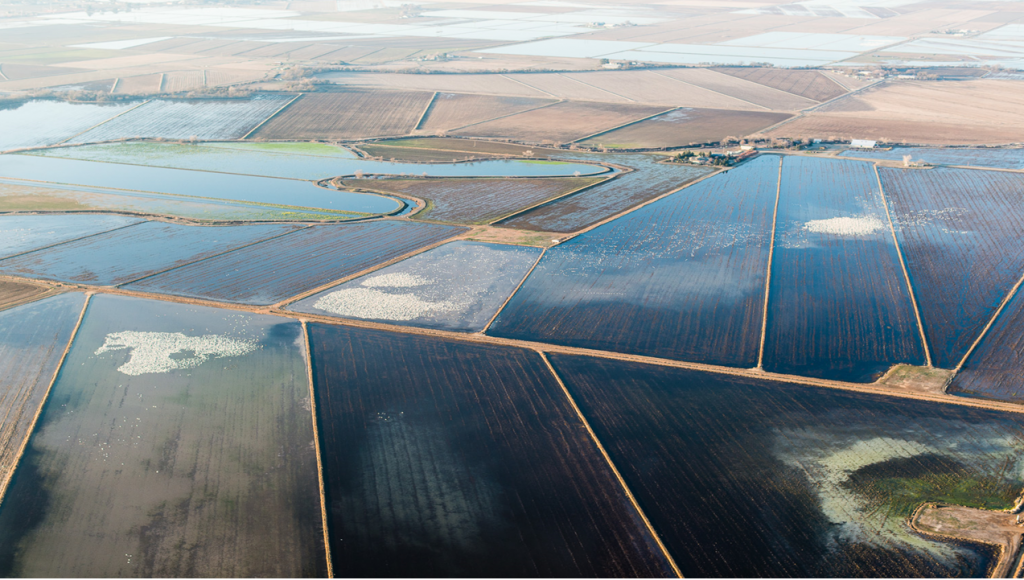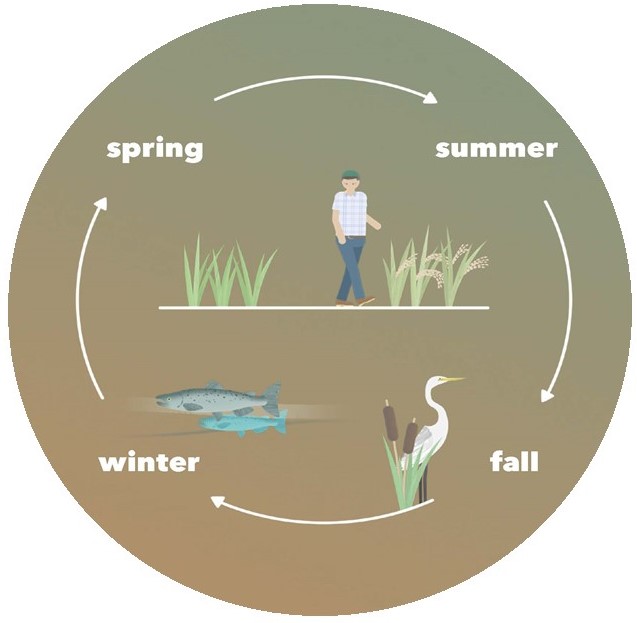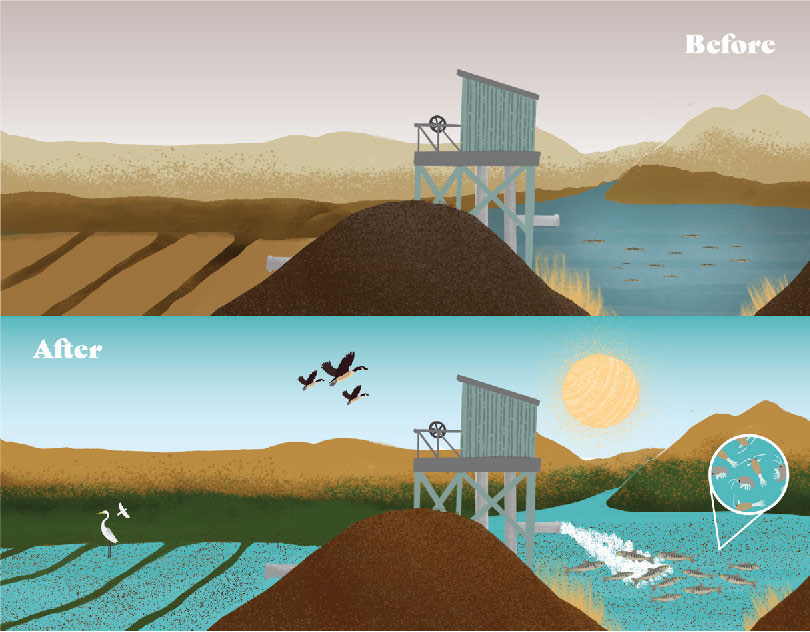By: Roger Cornwell, River Garden Farms
Jacob Katz, PhD, California Trout

A first-of-its-kind study reveals that rice fields can play an important role in revitalizing river ecosystems and boosting imperiled salmon populations in the Sacramento Valley. California Trout, working with River Garden Farms and a coalition of farmers and public agencies, recently completed a detailed three-year experiment detailing how farm fields can be managed to grow food to support wild salmon populations in the fall and winter months, while still growing food for people during summer. We summarized the scientific studies in Fish Food on Floodplain Farm Fields. (See the full studies for 2019, 2018 and 2017.)
California’s native fish populations are struggling for survival. Before the Central Valley was developed, leveed and drained, over four million acres of floodplains were inundated each winter. These shallow, fertile floodplains were hugely productive and created the food that supported over two million salmon, tens of millions of waterfowl and abundant wildlife populations. Over last 150 years more than 95 percent of floodplains have been cut off from Central Valley rivers by levees, effectively starving river ecosystems of the foundation of the aquatic food web: the solar energy captured by plants and algae on floodplains that in turn feeds the bugs that are the primary food source of juvenile salmon. There is a growing body of research that points to a lack of available fish food in channelized Central Valley rivers as a leading cause in the dramatic and continuing decline of native fish populations.
The idea behind the “Fish Food From Floodplain Farm Fields” experiment was for scientists to partner with growers who farm the formerly-inundated floodplains on the dry-side of the levees to manage their fields in such a way that they reproduce the natural pattern of mid-winter flooding. When the farmers shallowly inundate their fields for several weeks they replicate the natural wetland conditions that once made abundant fish food. In several weeks in mid-winter, when the fields are not otherwise in use, a massive growth of invertebrates bloom in these fertile floodplain waters. These water bugs can then be drained off the farm fields back to the river, where they provide food for the starving juvenile salmon who are stuck in the food-deprived river channel. As the scientific results suggest, this collaborative approach makes possible a new way forward in which farmers and natural resource managers work together to make every acre of land and every drop of water work together for both people and native fish and wildlife.

Several years ago, the Nigiri Concept studies proved that juvenile salmon grow at a much faster rate when they have access to floodplain-like habitat on flooded farm fields in the Central Valley’s flood bypasses (bypass fields are on the wet-side of the levees which connect directly to the river during flood).
Here is how it works. In fall after rice harvest, farmers re-flood their rice fields using the same irrigation canals that were used to irrigate the fields in summer. But now the water is being used to mimic the natural floodplain conditions needed to reactivate the floodplain’s explosively productive aquatic food web. Inundating these floodplain farm fields that used to be a wetland creates conditions similar to those that occurred naturally. Wetlands are some of the most productive habitats on earth. In the shallow water, bacteria and fungi break down the plant matter that grew on the floodplain during summer, these microbes are then eaten by billions of small crustaceans and insects called zooplankton. The zooplankton, in turn, feed small fish. In a very short time small fish become bigger, healthier fish on this energy-rich bug diet. That’s important because a bigger and fatter juvenile salmon has a much better chance of coming back from its journey out to sea as a large 30 lb. adult than a smaller, less fit fish.
This Fish Food study takes the floodplain farm field concept to the next level and shows that rice fields on the dry-side of levees can also benefit fish and river food webs if the billions of bugs grown on these fields are delivered into the nearby river to provide essential food supplies for the native fish stuck in the food-deprived river channels. A short film showing how this works can be seen here.
Our study explored the ecological impact and operational feasibility of increasing fish food supplies (i.e., increasing the number of zooplankton) in the Sacramento River. The project used existing water infrastructure managed by Reclamation District 108 and landowners to shallowly flood approximately 5,000 acres of Colusa Basin farm fields during the non-growing season. Within three weeks of flooding, the shallowly inundated fields swarmed with zooplankton. A month after flood-up we began draining the floodplain water, now rich with floodplain-derived fish food back into the river. As the water poured back into the river it brought the zooplankton populations that had developed on the fields into the river for those starving fish to eat.

During the month while floodplain water was being drained, the number of zooplankton in the Sacramento River increased forty-fold at the point where the floodplain water fields entered the river. Even more remarkably, one mile downstream from the drainage point zooplankton food resources were still six times greater compared to typical food levels in the river.
To test the effect of these increased zooplankton populations on fish, juvenile Chinook salmon were held in floating cages in the river in three locations: upstream of the location of where the floodplain water was discharged into the river; at the site of the river discharge; and one mile downstream of the discharge site. Fish caged at the site where the food-rich water was returned to the river grew five times faster than fish caged in similar habitats upstream where they didn’t have access to the floodplain fish food. Fish caged one mile downstream from the discharge point grew three times faster than those upstream of the discharge point.
A different study published in December by colleagues at UC Davis indicated that having access to abundant food resources “may help buffer the effects of increasing water temperature” for cold-water fish like salmon. As climate change-related extremes become more common, ensuring sufficient food is available for salmon in Central Valley rivers is one more way to bolster their chances of survival. In essence, with some help from us to reactivate productive Central Valley floodplain habitats, salmon may have a chance to eat their way out of climate change.
These results show that there is a tremendous amount local farmers and irrigators can do to support salmon recovery by taking a more deliberate approach to how we move water through our fields during the non-growing season. Over the last 30 years, Central Valley farm fields managed for water bird habitat have helped recover migratory bird populations along the Pacific Flyway. This has been a tremendous success story that demonstrates the power of managing working lands for the benefit of wildlife. Coordinated efforts like this experiment also show that we can refine how we manage limited water supplies in the Central Valley to help stressed fish populations recover in areas where agricultural operations and wildlife refuges are vibrant. Our hope is that, with the cooperation of public agencies and other landowners, we can scale up this collaborative, science-based approach so that the river ecosystem of the Sacramento Valley can once again produce abundant populations of salmon and other native fish.

We appreciate the broad partnership to advance this work. In addition to California Trout and River Garden Farms, we have partnered with the United States Bureau of Reclamation, Reclamation District 108, Robbins Rice Company, Davis Ranches, Montna Farms, the California Rice Commission and the UC Davis Center for Watershed Sciences. The project was funded by the United States Bureau of Reclamation, the Water Foundation, public agencies and participating farms, with support by the Northern California Water Association.
For more information on the reactivating floodplains partnerships and the new way forward, we recommend two films: The New Way Forward and No Going Back.
For more information, see the full studies for 2019, 2018 and 2017. A slide presentation on these floodplain topics is here. Please contact us at rcornwell@rivergardenfarms.com or jkatz@caltrout.org if you have any questions or would like more detailed information on these studies or to receive a full presentation on the results.
For our personal stories, see Winter Farming At River Garden Farms and Chasing Nigiri.



